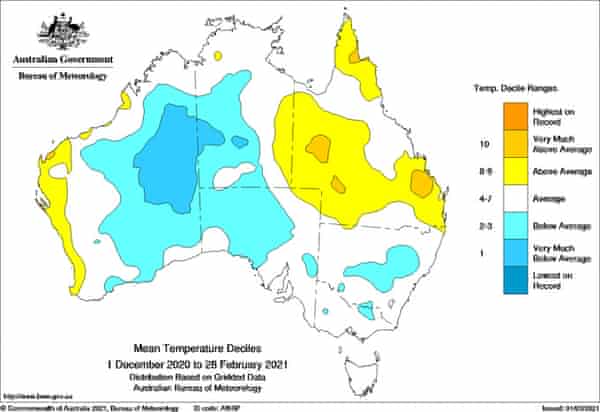The summer just gone was Australia’s wettest in four years, with official data showing there was above average rainfall as a cooling La Niña imposed itself across much of the continent.
The average temperature across the continent was slightly above average, representing a respite from the previous two summers that remain in the nation’s top two on record for heat.
Data from the Bureau of Meteorology showed the wet summer included an especially drenched December. Countrywide, it was the third wettest on record going back to 1900.

The bureau said the temperature across the season was just 0.06C above average, and maximum temperatures were 0.28C below average. However, nights were warm – 0.39C above the long-term average, calculated from 1961 to 1990.
The wettest summer since 2016-17 came after the two hot and dry summers that had featured a sharp and extended drought and, in 2019-2020, catastrophic bushfires.
Ben Domensino, a meteorologist at Weatherzone, said the summer was the coolest for daytime temperatures for nine years. The rain and mild temperatures could both be credited to the La Niña weather pattern that tended to increase cloud cover and rainfall, he said.
“Rainfall was plentiful over much of Australia between December and February, with the country having its wettest summer in four years,” Domensino wrote. “For the Murray-Darling Basin, it was the wettest summer in a decade.
“The cooling effect of La Niña, both in Australia and globally, can mask the background warming signal that’s occurring as a result of contemporary climate change.”
BREAKING: Australia just had its coolest summer in 9 years, with a mean temperature 0.06ºC above the 1961-1990 average. It was also Australia’s wettest summer in 4 years, underpinned by #LaNiña
Image: @BOM_au pic.twitter.com/dTnHNc7ZrO
— Ben Domensino (@Ben_Domensino) March 1, 2021
According to the bureau, rainfall was 29% above average.
There were exceptions: eastern Queensland from Mackay south was drier than average.
While the 2020 calendar year was Australia’s fourth-warmest on record, continuing a run of record warm years over the past decade – and 2018/19 and 2017/18 were the hottest and second hottest recorded – the most recent summer was only the 66th warmest out of 111 years.
The greater than usual summer rain was in line with a bureau forecast in November that it was likely to be wetter than average across most of the country.
At the time, the bureau said two seperate weather patterns would drive the wet weather.

Temperatures in the waters of the tropical Pacific were in a La Niña phase that tended to bring more rain to the east of the continent, and the belt of westerly winds to the south of the continent was also in a position likely to bring more rain.
The bureau’s climate statement for summer 2020-21, published on Monday, said a cold front and low pressure trough had brought tropical moisture into Victoria and southern New South Wales from late January to early February.
For rainfall, the state’s seeing modest increases were Tasmania, with 14% above average, Queensland (+8%), Victoria (+14%) and South Australia (+14%).
Rainfall was well above average in NSW (+29%), WA (+54%) and NT (+39%). The Murray-Darling basin also had a summer with rainfall 13% above average.

Average Rating